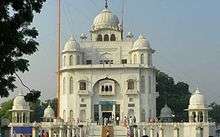Gurdwara Rakab Ganj Sahib

The Gurdwara Rakab Ganj Sahib is a historic gurdwara near Parliament House in New Delhi. It was built in 1783, after Sikh military leader Baghel Singh (1730–1802) captured Delhi, on 11 March 1783, and his brief stay in Delhi, led to the construction of several Sikh religious shrines within the city. This one marks the site of cremation of the ninth Sikh Guru, Guru Tegh Bahadur, after his martyrdom in November 1675 for saving Hindu Kashmiri Pandits, under orders of Aurangzeb. The Gurudwara Sahib is built near old Raisina village near Raisina Hill, at present Pandit Pant Marg, took 12 years to build. Prior to that, a mosque had been built near the spot; eventually later Mughal emperor Shah Alam II gave the permission to build a Gurdwara sahib there.[1]
The Gurdwara Rakanganj sahib is also home to the Delhi Sikh Gurdwara Management Committee.
History
The Gurdwara marks the site, where Lakhi Shah Banjara and his son Bhai Naghaiya burnt their own house to cremate the body of the Sikh Guru Guru Tegh Bahadur sahib who, on 11 November 1675, was martyred by beheading at Chandni Chowk on the orders of the Mughal emperor Aurangzeb for refusing to convert to Islam. The spot where the Guru sahib were beheaded is marked by Gurdwara Sis Ganj Sahib. The Guru sahib's severed head was brought from Delhi to Anandpur Sahib in Punjab by Bhai Jaita ji (later Bhai Jiwan Singh) and was cremated by his son, Guru Gobind Rai, who later became Guru Gobind Singh, the tenth Guru of the Sikhs. [1][2][3]
The Delhi Sikh Gurdwara Management Committee is planning to build a memorial to the Sikhs killed during the 1984 Anti-Sikh genocide at the site. Though the foundation stone for the memorial has been laid, the Delhi High Court is considering a petition challenging the construction of the memorial.[4]
References
- 1 2 H. S Singha (2000). The encyclopedia of Sikhism. Hemkunt Press. p. 187. ISBN 81-7010-301-0.
- ↑ H.S. Singha (2005). Sikh Studies, Book 7. Hemkunt Press. p. 43. ISBN 81-7010-245-6.
- ↑ Mohindar Pal Kohli (1992). Guru Tegh Bahadur: testimony of conscience. Sahitya Akademi. p. 36. ISBN 81-7201-234-9.
- ↑ Nibber, Gurpreet Singh (12 June 2013). "Foundation stone of 1984 Sikh genocide memorial laid". Hindustan Times.
External links
- ↑ Guru Gobind Sing Guru